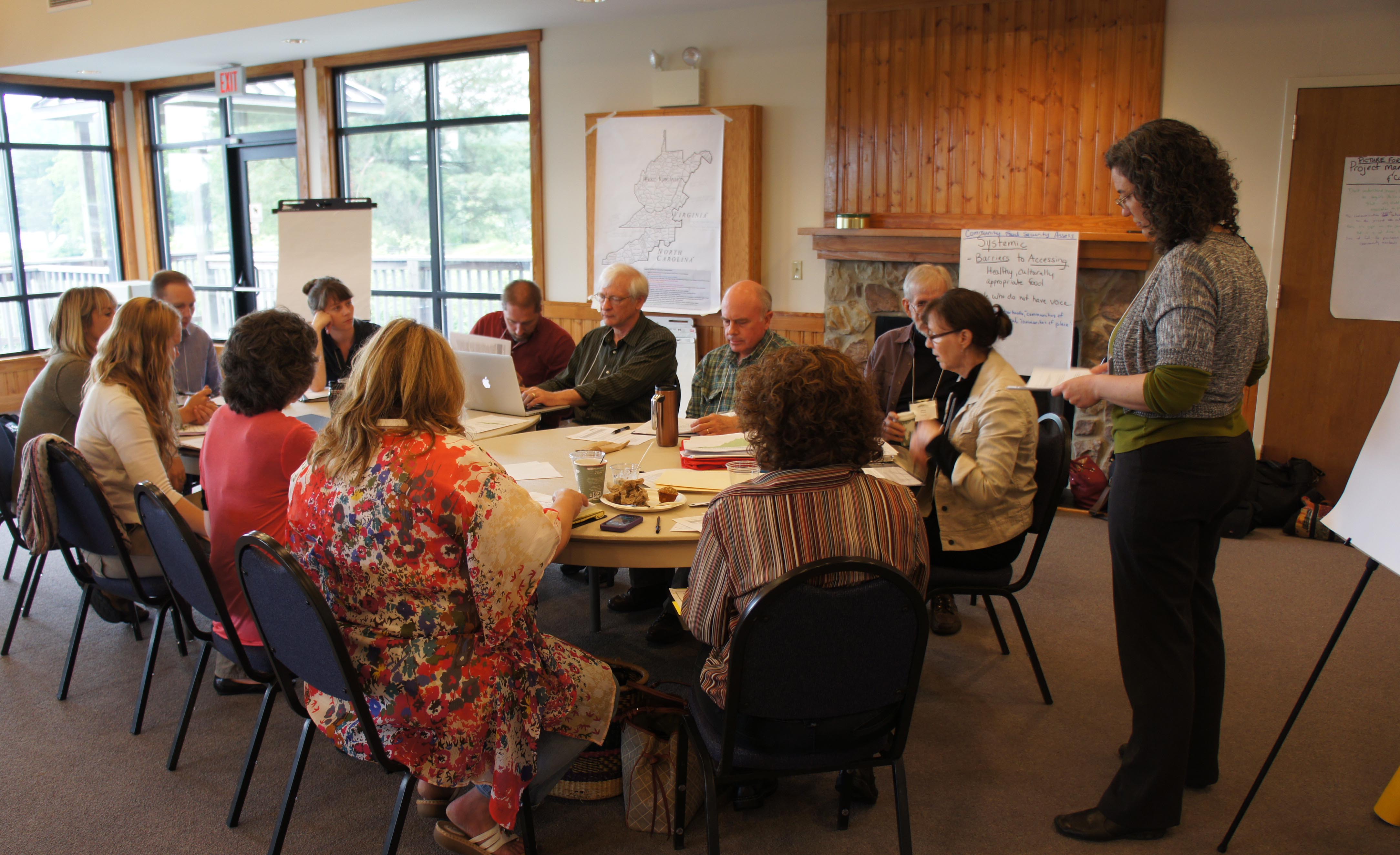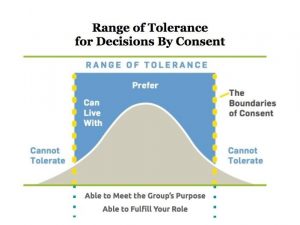In Propositions for Organizing with Complexity: Learnings from the Appalachian Foodshed Project (AFP), Nikki D’Adamo-Damery described nine propositions that emerged from the work of the AFP. Proposition #2 was: “Establish Consent instead of Consensus.” The following story describes one of the experiences we had together, when Tracy was facilitating the management team, that led to this proposition.

This story begins when the AFP management team was making decisions about how they were going to award mini-grants to on-the-ground projects that addressed community food security. The team included the principal investigators, graduate students, extension agents, and representatives from community-based organizations, and so reflected some of the diversity of the system within which they were working. The team was using a collaborative decision-making framework, and the basis for decisions was the principle of consent.
[ap_spacing spacing_height=”15px”]
The principle of consent
People often think there are only two choices for how we make governance decisions: by majority or consensus. Most people fail to realize that decision-makers have a third option – decision-making by consent – that can be preferable to either of these for governance decisions. The Consent Principle means that a decision has been made when no member of the group has a significant objection to it, or when no one can identify a risk the group cannot afford to take. In other words, the proposal is not out of their Range of Tolerance (see below). Those risks are things that would undermine the purpose, or that would create conditions that would make it very difficult for a member to perform his or her role.
[ap_spacing spacing_height=”15px”]
The test for the management team
The urgency to get the funds out into the field put pressure on the team to make a decision. On the one hand, there was clear value in having these different perspectives at the table as they discussed funding priorities and how to make the application process more accessible. On the other hand, there were conflicting opinions when it came to designing the application. Was it ethical for representatives from community agencies who might apply for the grant funds, to design the actual application? A professor said “no” and a community agency rep said “yes.” There were concerns that the difference of opinion might limit progress.
[ap_spacing spacing_height=”15px”]
Consent is grounded in dialogue, not debate
It was through this experience that they learned that, by using consent as the basis for decisions, the team did not have to agree. Instead of debating, they inquired into what was out of the range of tolerance for each of them. They listened to each other’s objections as feedback about potential risks so they could adjust the solution to mitigate those deemed unacceptable.
Here’s what they discovered:
- The professor was actually concerned that there might be a perception about a conflict of interest if the community partners applying for awards were involved in the design of the application questions. That perception was the risk the project could not afford to take — because it would undermine the project’s credibility and trust in the community.
- The non-profit director was concerned about the integrity of inviting community reps into the decision-making process, and then withholding that power when issues got sticky. That power dynamic was a risk the project could not afford to take — because it would undermine the trust within the core team.
Once they discerned the reasons for concern – and chose to respect what was important to each of them – they found a way forward. The decision was to include the community partners in decisions about the application design, as full decision-makers, AND to be fully transparent in all public communications about their participation. As a side note, they were simultaneously clear that, if one of those community-based organizations applied for a grant, they would recuse themselves in the selection of grant recipients.
The grant application design and process went mostly smoothly with no conflict of interest issues. The second round of distribution of mini-grants moved even more quickly, building on the trust that had been built the first time around.
This blog post originally ran on the Virginia Cooperative Extension: Community, Local, and Regional Food Systems blog. and at CircleForward.us
*The Appalachian Foodshed Project (AFP) originated in 2011 as a grant funded through the USDA’s Agriculture, Food and Research Initiative (AFRI) grants program (Award Number: 2011-68004-30079). Virginia Tech served as the lead academic institution in partnership with North Carolina State University and West Virginia University for a five-year endeavor to address community food security in western North Carolina, southwest Virginia, and West Virginia.
By Tracy Kunkler, MS – Social Work, professional facilitator, planning consultant, and principal at http://www.circleforward.us/[ap_spacing spacing_height=”15px”]
Please post any thoughts, comments or stories in the comments section below.
1 Comment
Comments are closed.

Thank you for your work and written word with graphics! I am looking for people that will work with me to reveal a way to weave the gaps in the existing “health insurance” system.
The people must be willing to use my Cisco WebEx Event Center and the Wellness Weavers’ “Bee Attitudes” to integrate wellness principles and fun to improve the benefits and function.
I have an idea to offer one-hour web-based interactive training sessions for all citizens so they can learn and apply these collaborative innovation techniques to bridge between all their local or our global partners.
I was a home health nurse at Frontier Nursing Service for 6 months in 1977 and that is what caused me to reset my course to study Community Health with a foundation of Wellness and empowerment for the return of food gardens and orchards as a core piece.
The issue that I face is that I need a diverse team that already have these skills and will be grateful and excited to use me and my assets correctly. Wellness Weavers, Inc just went into “Delinquent” status with the State of Kansas because I want to update my record with a fun and functional team before I file my report and pay the annual fee. My team can be from anywhere that has access to Internet.
My Wellness Weavers website looks like a one-woman show and tell because it is the manifestation of eight years of me trying to find people that will stop telling me the concept is too big and “good luck”. The generation that believed in me has died and their money and mine that bought this campus and technologies will have been wasted if no team emerges soon.
The federal and state government and the United Methodist Church Global Board of Mission and Global Board of Discipleship are hoping that the string of evidence of the equitable system of the Wellness Weavers pilot project offers do not get out or it will embarrass the past and present leadership and weave many of the gaps in all forms of “health insurance” and poverty.